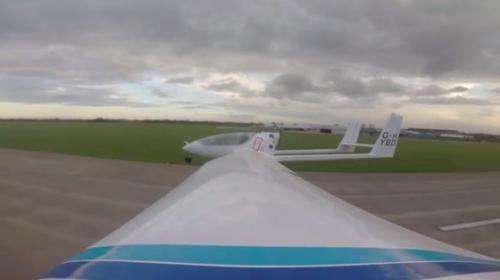January 27, 2015 weblog
Aircraft with a parallel hybrid engine tested in UK

More research is needed before commercial airliners will be powered entirely with electric motors but tests with hybrid designs are turning up interesting results. Researchers from the University of Cambridge in association with Boeing have tested an aircraft with a parallel hybrid engine in the UK, the first ever to be able to recharge its batteries in flight. The Cambridge report said that the test flights took place at the Sywell Aerodrome near Northampton. The tests involved hops along the runway and evaluation flights at a height over 1,500 feet.
This was a "parallel hybrid electric propulsion system," where an electric motor and petrol engine were designed to work together. One may say the tests are encouraging as early steps to a future goal of cleaner, low-carbon air travel as engineers explore designs that can result in planes using less fuel than petrol-only engines. Cambridge University's Dr. Paul Robertson, Department of Engineering, who led the project, said that, as for land vehicles, we now have hybrid cars where engineers have explored how they can achieve the same performance and fuel economy within the same vehicles. But, as for aircraft, "there are no commercially available hybrid aircraft." The reason for the lag is that research is still at a relatively new stage.
"The batteries really haven't been good enough." He said they have been too heavy for a given energy capacity to be viable in aircraft. "Although hybrid cars have been available for more than a decade, what's been holding back the development of hybrid or fully-electric aircraft until now is battery technology," he stated. "If you just run a quick, back of the envelope calculation, if you were to replace all the engines and all the fuel in an airliner with batteries, you would fly for just under ten minutes." Nonetheless, scientists are encouraged about the advent of lithium polymer batteries. Robertson said, "we are at the point where their energy density is now viable, where you can begin to look at hybrid aircraft and indeed entirely electric aircraft albeit with a reduced range." The researchers built a hybrid demonstrator as a lightweight single-seater aircraft. The aircraft uses a combination of a 4-stroke piston engine and an electric motor/generator. A power electronics module designed and built in the Engineering Department controls the electrical current to and from the batteries; a set of 16 large lithium-polymer cells is located in special compartments built into the wings.
With a hybrid design, the power needed for takeoff and climb is considerably higher than when up in cruise. They get a very high power burst for takeoff and climbing; then once up in the cruise height, they reduce the electric power, perhaps even down to zero, said Robertson, and the petrol-burning engine is running at its most efficient point. As the Cambridge University similarly explained, "During take-off and climb, when maximum power is required, the engine and motor work together to power the plane, but once cruising height is reached, the electric motor can be switched into generator mode to recharge the batteries or used in motor assist mode to minimize fuel consumption. The same principle is at work in a hybrid car."
The researchers' hybrid aircraft is basically a test bed, said Robertson. They collect flight data and use that data to validate the theoretical computer models, looking to see if the entire package behaves as it should. They also view the work as a useful test bed to evaluate different technologies.
The report said their demonstrator aircraft uses up to 30 percent less fuel than a comparable plane with a petrol-only engine.
© 2015 Tech Xplore



















